1. Refer to the exhibit. The network administrator enters the command that is shown in the exhibit and then is the show ip route command. The route added by the network administrator is missing from the routing table. What is the reason for this?
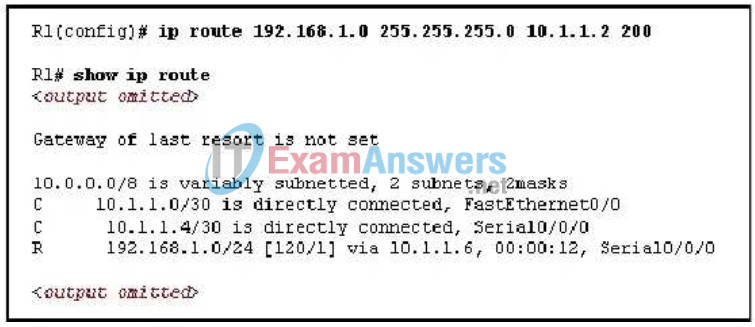
- This static route is providing a backup to the existing route to 192.168.1.0 /24.
- The route is incorrectly configured.
- Dynamic updates are always preferred over static routes.
- The FastEthernet0/0 interface is administratively down.
2. Refer to the exhibit. None of the hosts in network A are able to access the Internet. How can this problem be resolved?
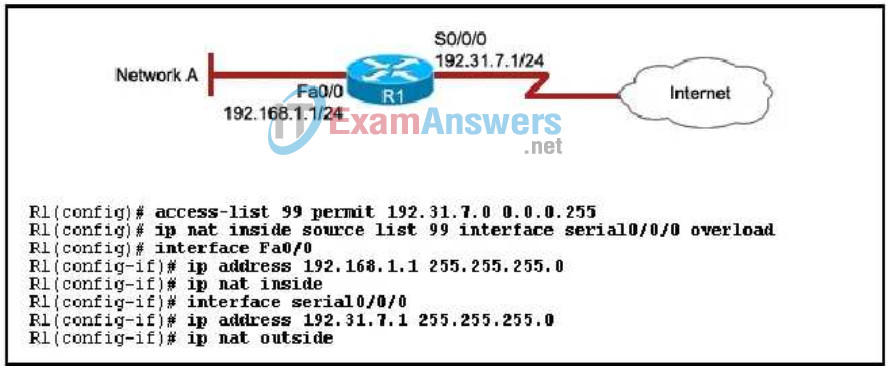
- Configure dynamic NAT instead of PAT.
- Configure the access list for the correct network.
- Include the ip nat pool command in the configuration.
- Configure the ip nat inside command on the correct interface.
3. Refer to the exhibit. Routers R1 and R2 cannot communicate. What could be the cause of the problem?
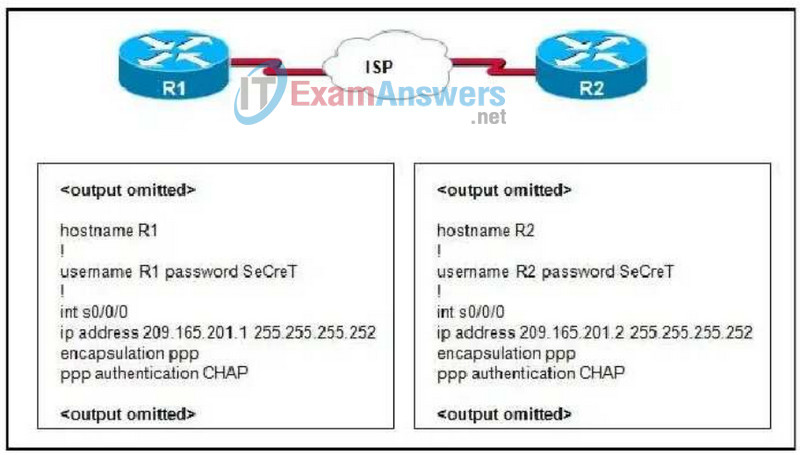
- Usernames on both routers R1 and R2 are misconfigured.
- The passwords are identical on both routers.
- The encapsulation command is entered incorrectly.
- The IP addressing scheme has incorrect subnet masks.
4. Refer to the exhibit. Which two facts can be determined from the output? (Choose two.)
- The router ID of R2 is 192.168.100.65.
- R2 has established adjacencies with three routers.
- R2 is not receiving hellos from neighbor 192.168.100.66.
- R2 is connected to an Ethernet network that consists of two routers.
- Neighbor 192.168.100.3 will become the DR if the current DR becomes unavailable.
5. Refer to the exhibit. What is the administrative distance for OSPF routes?

- 01
- 6565
- 110
- 120
- 128
6. Which statement describes a PVC?
- A PVC provides a permanent logical connection to forward data between two points.
- A PVC is dynamically established when a router requests a transmission.
- A PVC prevents small messages from being held up behind larger messages.
- A PVC requires call set-up information to be sent before transmitting any data.
7. A sales representative is preparing to send sensitive information to corporate headquarters from a hotel room using the Internet. Prior to the trip, the IT staff made the necessary provisions to allow secure Internet access. What solution was implemented for the sales representative?
- VPN
- Frame Relay
- PPP with CHAP authentication
- PPP with PAP authentication
8. What are two characteristics of a static route? (Choose two.)
- A static route can be used by border routers to provide secure and stable paths to the ISP.
- By default, a static route is more secure than dynamic routing.
- A static route automatically adapts to topology changes.
- A static route can only be used with classful addressing schemes.
- A static route creates processing overhead in a large network.
9. What is one major difference between RIPv1 and RIPv2?
- RIPv2 has a higher maximum hop count than RIPv1.
- RIPv1 utilizes broadcasts. RIPv2 utilizes multicasts.
- RIPv1 supports discontiguous networks. RIPv2 does not.
- RIPv1 updates are exchanged more often than RIPv2 updates.
10. Refer to the exhibit. The network administrator wants to restrict the Production network from accessing the HR network. All other traffic will have access to all networks. Which combination of interface and direction should the administrator use to apply the ACL?
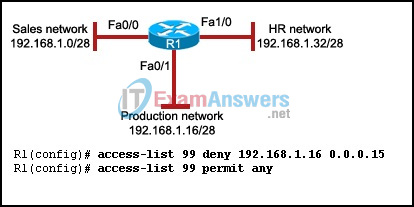
- Fa0/1, out
- Fa1/0, out
- Fa0/1, in
- Fa1/0, in
11. Refer to the exhibit. OSPF has been configured on all routers. What is the DR/BDR status immediately after all routers have converged?
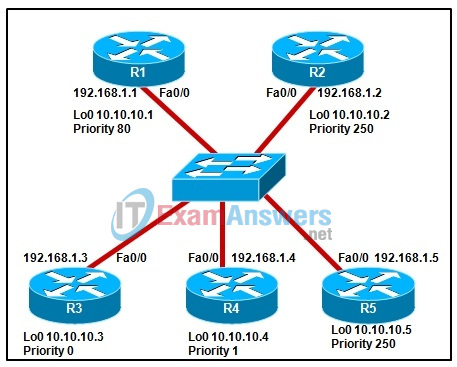
- R1 is the DR. R3 is the BDR.
- R2 is the DR. R5 is the BDR.
- R3 is the DR. R4 is the BDR.
- R4 is the DR. R5 is the BDR.
- R5 is the DR. R2 is the BDR.
12. Refer to the exhibit. Workstation H1 is unable to reach the Internet. A network technician issues a ping command to troubleshoot the problem. Based on the results of the commands that are shown, what could be cause of the problem?
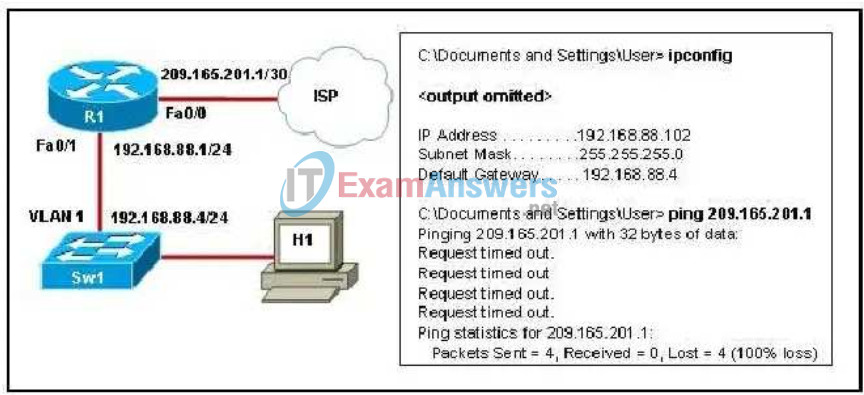
- The default gateway on H1 is incorrect.
- The IP address on H1 is incorrect.
- The subnet mask on H1 is incorrect.
- The Fa0/0 IP address on the router is incorrect.
- The VLAN IP address on the switch is incorrect.
13. Refer to the exhibit. The network administrator has configured R1, R2, and R3 to use RIPv2, and the network is fully converged. The hosts on the internal network are able to access R2, but they are unable to access the Internet. How can the administrator solve this problem?
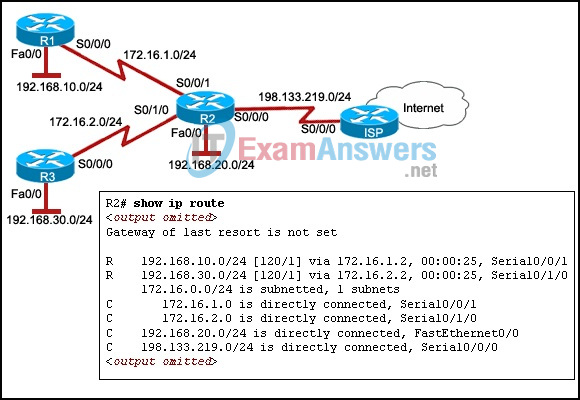
- Configure a default route on R3 and propagate it via the use of RIPv2 to all routers.
- Configure a default route on R2 and propagate it via RIPv2 to routers R1 and R3.
- Configure a default route on the ISP, and it will be automatically propagated to all routers.
- Configure a default route on R1, and it will be automatically propagated to all routers.
14. What are two features of a standard IP ACL? (Choose two.)
- It permits or denies access based on the entire protocol.
- It filters the packet based on the source IP address only.
- It uses identification numbers between 100 and 199.
- It can filter traffic based on port number.
- It can only filter inbound traffic on an interface.
15. Refer to the exhibit. A network technician is attempting to manage a switch that has an IP address that has been assigned to the default management VLAN. What is a possible reason that the Telnet session fails from a PC connected to a port that is assigned to VLAN 10?
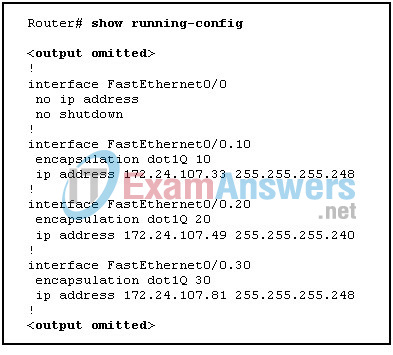
- The incorrect encapsulation command is used.
- There is no encapsulation dot1q 1 configuration on the FastEthernet 0/0 port.
- The default gateway address of the switch must be in the same network as the PC.
- There is no subinterface associated with the default management VLAN on the switch.
16. A router in a fully converged EIGRP network detects that a remote route is unreachable. Which two events may occur next? (Choose two.)
- EIGRP will look for a feasible successor in the routing table.
- DUAL will calculate the highest cost routes to each network.
- EIGRP will send a bounded update to alert neighbors about the failure.
- The router will forward the complete routing table to the neighboring routers.
- DUAL will look for a feasible successor route in the topology table and, if one is found, it will add this route to the routing table.
17. When MD5 authentication is used for OSPF routing protocol authentication, what two facts are known about the key? (Choose two.)
- The key passes between routers in plain text.
- The key is used to help generate an encrypted number for authentication.
- The key passes between routers in encrypted form.
- The key is never transmitted.
- The key can be captured by using a packet sniffer.
18. While using the Class A addressing scheme, a network administrator decides to use the 255.255.254.0 subnet mask in the network configuration. How many host addresses can be created for each subnetwork in this addressing scheme?
- 510
- 512
- 1022
- 1024
19. Refer to the exhibit. The routing protocols are configured with their default settings. Which two statements a true about the path or paths that R1 will choose to the 192.168.2.0/24 network? (Choose two.)
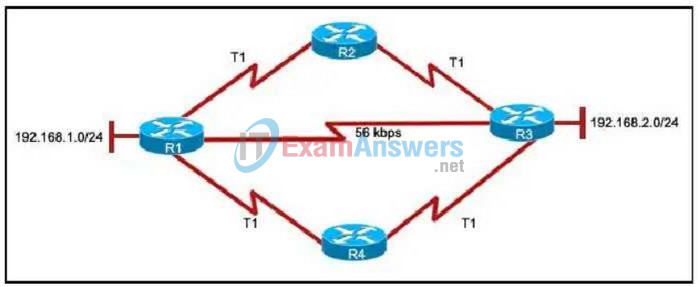
- If only EIGRP is configured on the network, only the path R1->R3 will be installed in the routing table.
- If OSPF and RIPv2 are both configured on the network, only OSPF paths will be installed in the routing table.
- If EIGRP and OSPF are both configured on the network, only EIGRP paths will be installed in the routing table.
- If EIGRP and RIPv2 are both configured on the network, only RIPv2 paths will be installed in the routing table.
- If RIPv2 is the routing protocol, the two equal cost paths (R1-R2-R3 and R1-R4-R3) will be installed in routing table.
20. Where are EIGRP successor routes stored?
- only in the routing table
- only in the neighbor table
- in the routing table and the topology table
- in the routing table and the neighbor table
21. A network administrator is configuring an edge router to support external access to several internal web server that have private IP addresses. Which type of address resolution would be appropriate for this scenario?
- PAT
- static PAT
- static NAT
- dynamic NAT
22. What is the function of Inverse ARP in a Frame Relay network?
- It maps the IP address to the MAC address.
- It maps the MAC address to the DLCI.
- It maps the DLCI to the remote IP address.
- It maps the local IP address to the remote MAC address.
23. What can be done to reduce the impact of a failure domain?
- Create a single local network on a central switch.
- Move wired users to a more reliable wireless network.
- Add redundant devices to key positions within the network.
- Add more VLANs to each switch and assign fewer users per VLAN.
24. Refer to the exhibit. Server7 has been added to the server farm network. The hosts can ping Servers 2 and 3 and Server2 and Server3 can ping each other. Server7 cannot ping the other servers connected to the switch. What is the cause of this problem?
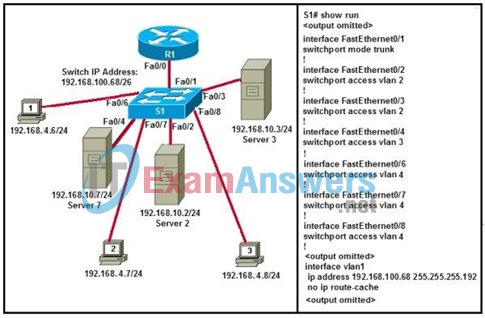
- The Fa0/1 port on the switch should be in access mode.
- The switch IP address is not on the same subnet as Server7.
- The switch port used for Server7 is not in the same VLAN as Server2 and Server3.
- The Fa0/0 interface of the router has not been configured for subinterfaces to support inter-VLAN routing.
25. Refer to the exhibit. What is the purpose of assigning the IP address 192.168.30.1 to an access layer switch?

- to assign a default gateway to the hosts that are connected to the switch
- to allow hosts on the same LAN to connect to each other
- to allow remote management of the switch
- to allow inter-VLAN communication
26. Refer to the exhibit. An administrator sees this error message after entering commands to configure a router interface. Which command could the administrator enter that would avoid the error?

- Router(config-if)# ip address 192.168.4.0/24
- Router(config-if)# ip address 192.168.4.1 255.255.255.0
- Router(config-if)# ip address 192.168.4.0 255.255.255.240
- Router(config-if)# ip address 192.168.4.255 255.255.255.0
27. A network administrator wishes to log ACL messages on a remote server. Which two procedures should be completed for the remote logging to be successful? (Choose two.)
- Configure logging to a syslog server IP address.
- Configure logging to the router loopback IP address.
- Ensure that logging to the console is configured.
- Apply the terminal monitor command on the router.
- Restrict remote access by applying an ACL to all VTY lines.
- Verify that the clock is set to the correct date, time, and time zone.
28. Refer to the exhibit. An administrator is adding a new router to the network. The IP address 192.168.13.6/30 has been assigned to the connecting serial interface on R2. What IP address must the administrator assign to the serial interface of the new router?
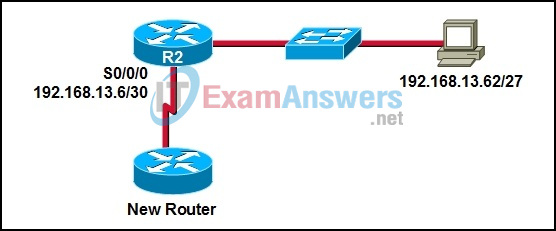
- 192.168.13.4/30
- 192.168.13.5/30
- 192.168.13.7/30
- 192.168.13.58/30
- 192.168.13.61/27
- 192.168.13.63/27
29. A journalist is using a wireless connection to transmit a video clip. Which is the best protocol to use to transmit the video packets?
- TCP
- UDP
- PPP
- HDLC
30. Refer to the exhibit. EIGRP has been configured on all routers in the network. Based on the outputs from the show ip route commands on R1 and R2, how will the routers process traffic from Host2 to the hosts on the 172.16.11.0/24 and 172.16.12.0/24 networks?

- The traffic will reach the destination networks.
- Traffic will be dropped by R2 because the gateway of last resort is not set.
- The traffic will reach the Null interface on router R1 where it will be dropped.
- Because EIGRP does not support discontiguous networks, the traffic from R1 will not reach R2.
31. Refer to the exhibit. A network administrator must manually summarize all IP addresses on the POP router for the ISP. Which one is the correct summary address?

- 192.168.0.0/22
- 192.168.0.0/23
- 192.168.0.0/24
- 192.168.0.0/25
32. Refer to the exhibit. The command that is displayed was run on a switch with 24 FastEthernet ports. Why are some ports missing from VLAN1?
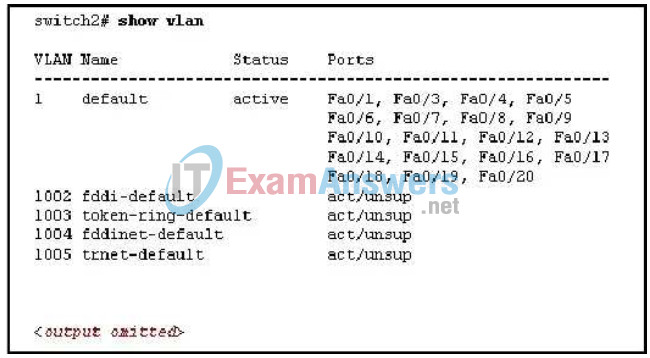
- The missing ports are administratively down.
- The missing ports are not configured for STP.
- The missing ports are not connected to any active device.
- The missing ports are configured for trunk ports.
33. Which three IP addresses are valid host addresses in the 10.200.0.0/20 network? (Choose three.)
- 10.200.11.69
- 10.200.16.1
- 10.200.0.255
- 10.201.0.55
- 10.200.15.240
- 10.200.30.29
34. Refer to the exhibit. Which IP addressing scheme would be correct for the network?

- H1-172.18.0.10/16
H2-172.18.0.11/16
H3-172.18.0.12/16 - H1-172.18.0.10/16
H2-172.19.0.10/16
H3-172.18.0.11/16 - H1-172.18.0.10/16
H2-172.18.0.11/16
H3-172.19.0.11/16 - H1-172.18.0.10/16
H2-172.19.0.11/16
H3-172.19.0.11/16
35. Refer to the exhibit. Which VTP function will this switch perform?

- It will create, change and share local VLAN information with other switches in the XYZ domain.
- It will forward to other switches the VLANs that are created in Switch1.
- It will back up the VTP database for domain XYZ.
- It will forward VTP configuration information for domain XYZ.
36. Which type of distance vector routing mechanism helps prevent the formation of loops by preventing routing information from exiting a router interface through the same interface on which it was received?
- split horizon
- hold-down timer
- poisoned reverse
- setting maximum hop count
37. Which two STP states allow a switch to learn MAC addresses? (Choose two.)
- blocking
- listening
- learning
- disabled
- forwarding
38. Which two statements are true regarding a PPP connection between two Cisco routers? (Choose two.)
- LCP tests the quality of the link.
- LCP manages compression on the link.
- Only a single NCP is allowed between the two routers.
- NCP terminates the link when data exchange is complete.
- With CHAP authentication, the routers exchange plain text passwords.
39. Refer to the exhibit. The network administrator has just configured a default route on the HQ router. What two statements describe what must happen so that all routers in the OSPF network have a route to the Internet? (Choose two.)
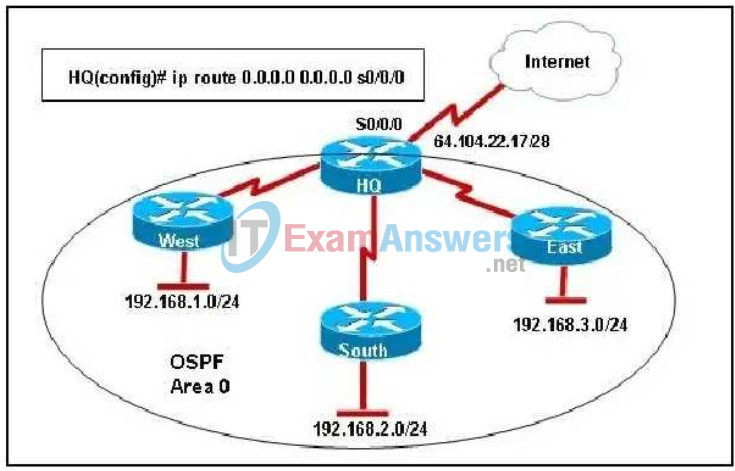
- The gateway of last resort must be set on each OSPF router.
- HQ will automatically propagate the default route to every other OSPF router.
- HQ will send the default route information to the DR and BDR for distribution to the other routers.
- Each router must be configured with a static route to the 64.104.22.16/28 network.
- HQ must be configured with the default-information originate command.
- Each router must include the statement network 64.104.22.16 0.0.0.15 area 0 in the OSPF configuration.
40. What is considered a best practice when configuring ACLs on vty lines?
- Use only extended access lists.
- Place identical restrictions on all vty lines.
- Apply the ip access-group command inbound.
- Remove the vty password since the ACL restricts access to trusted users.
41.Refer to the exhibit. EIGRP has been configured for all routers in the topology. For the network 10.1.2.0/24, which value represents the reported distance of the feasible successor?
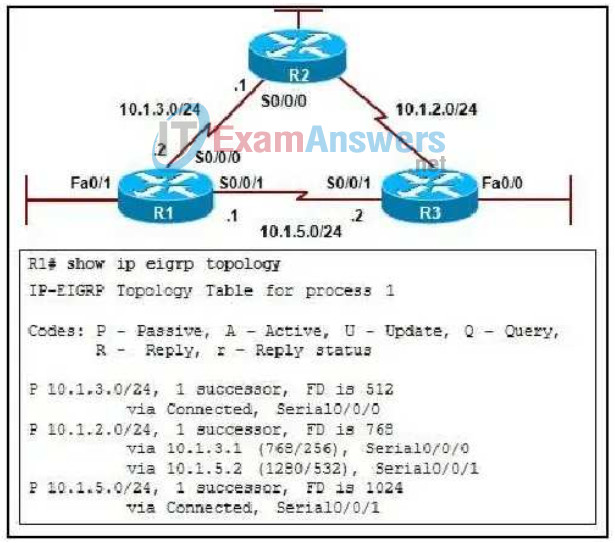
- 256
- 532
- 768
- 128
42. Refer to the exhibit. Host H2 and host H3 are able to ping the default gateway but cannot ping host H1. Host cannot ping either the default gateway, host H2, or host H3. The network technician issues the show interface command on switch S1 and notes that all unused switch ports are administratively down and ports Fa0/1, Fa0/3 and Fa0/4 are up with their line protocol up. However, S1 port Fa0/2 is shown as down with the line protocol down error (disabled). What is a possible cause for the inability of H1 to communicate with the network?

- Routing is misconfigured on router R1.
- The default gateway on H1 was misconfigured.
- Host H1 is on a different subnet than hosts H2 and H3.
- Port security on switch S1 port Fa0/2 is misconfigured.
- The administrative VLAN on switch S1 does not have an IP address assigned.
43. What are two advantages of using CHAP instead of PAP? (Choose two.)
- less router overhead
- more secure authentication
- immunity from replay attacks
- automatically configured username
- ssupport for both IP and non-IP based protocols
44. Refer to the exhibit. Switch1 and Switch2 are connected to each other via a trunk link that has been tested and is working properly. Why is VTP unable to propagate VLANs from one switch to the other?
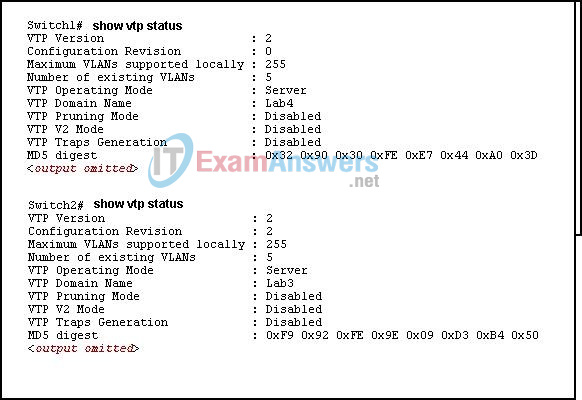
- The revision number is different on both switches.
- Both switches are in server mode.
- The VTP domain name is different on both switches.
- The VTP pruning mode is disabled.
45. A company requests the service of an ISP for Internet access. Which device is needed to connect the company router to the ISP by a T1 or E1?
- CSU/DSU
- DMZ router
- DMZ switch
- web server
46. Refer to the exhibit. Which access list, when applied inbound to the Fa0/0 interface of router R1, will prevent all IP traffic from the 172.16.1.16 network from entering the 172.16.1.32 network while allowing all other traffic?
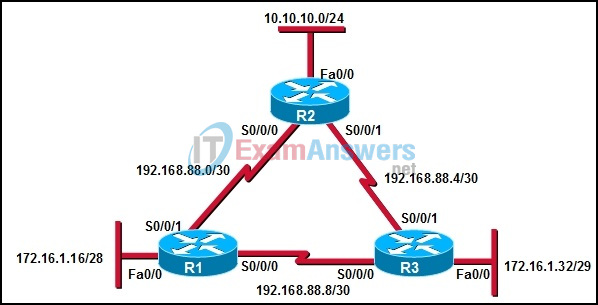
- access-list 101 deny tcp 172.16.1.16 0.0.0.7 172.16.1.32 0.0.0.15
access-list 101 permit ip any any - access-list 101 deny ip 172.16.1.16 0.0.0.15 172.16.1.32 0.0.0.7
access-list 101 permit ip any any - access-list 10 deny ip 172.16.1.0 0.0.0.255 172.16.1.32 0.0.0.255
access-list 10 permit tcp any any - access-list 101 deny tcp 172.16.1.16 0.0.0.15 172.16.1.32 0.0.0.7
access-list 101 permit ip any any
47. Which protocol is a classful routing protocol?
- BGP
- EIGRP
- OPSF
- RIPv1
- RIPv2
48. Which two statements are true when comparing RIP and EIGRP? (Choose two.)
- Both RIP and EIGRP support equal cost load balancing.
- Both RIP and EIGRP can run on Cisco and non-Cisco routers.
- RIP supports a maximum hop count of 15 while EIGRP supports up to 255 hops.
- By default RIP summarizes networks at the classful boundary while EIGRP does not.
- Routes learned via RIP have a lower administrative distance than those learned via EIGRP.
49. Refer to the exhibit. A network administrator is configuring an ACL on router R1. The purpose of the ACL is ensure that traffic from the Internet will only be allowed if it is in response to a request that is initiated from internal network. However, after the ACL has been applied, internal users report that they cannot visit external web sites. What can be done to solve this problem?
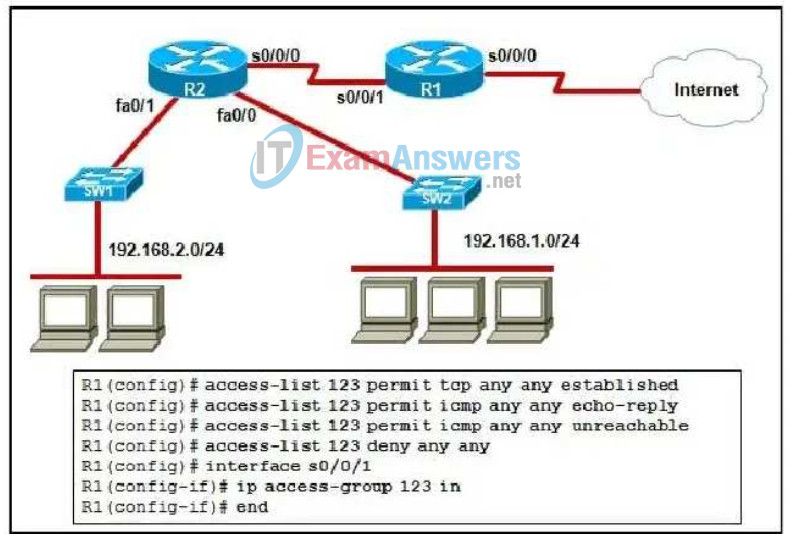
- Remove the deny any any statement.
- Apply the ACL to the serial 0/0/0 interface inbound.
- Consolidate all internal computers into one network.
- Add a permit tcp any any eq www statement to the top of the ACL.
50. Refer to the exhibit. A network administrator is configuring an ACL. Which statement is true about the effects the ACL?

- A host with the IP address 192.168.10.22 is allowed to access the FTP server that has the IP address
172.17.2.240. - A host with the IP address 192.168.10.42 is allowed to access the FTP server that has the IP address
172.17.2.241. - A host with the IP address 192.168.10.12 is allowed to access the web server that has the IP address
172.17.2.242. - A host with the IP address 192.168.10.52 is allowed to have SSH access to the server that has the IP add
172.17.2.240
51. Refer to the exhibit. R1 is connected to the Internet through its serial 0/0/0 interface. Hosts on the 192.168.100.0/24 LAN on R1 cannot communicate with hosts on the Internet. What two NAT configuration issues might explain this failure? (Choose two.)
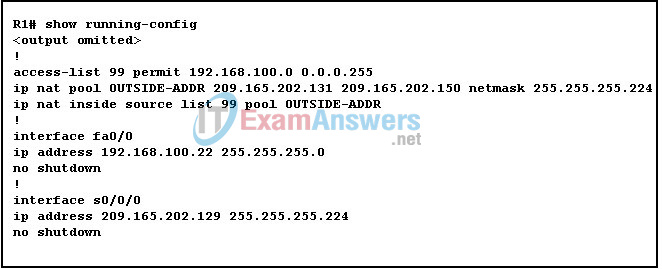
- The ip nat pool command has not been applied correctly.
- The inside interface has not been defined on R1.
- The access list does not include the group of IP addresses that are supported by the inside network.
- The ip address that is assigned to the serial 0/0/0 interface is incorrect.
- The outside interface has not been defined on R1.
52. Refer to the exhibit. Routers R1 and R2 are directly connected via interface Serial0/0 on each router but they are unable to communicate. What could be the cause of the problem?
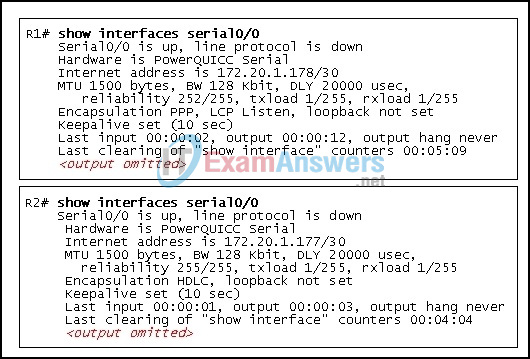
- The MTU is too high on both routers.
- The routers are not on the same network.
- A loopback address is required on both routers.
- The routers are not using the same encapsulation.
- Both interfaces require a no shutdown command to be issued.
53. Refer to the exhibit. All routes in the exhibit are available to a router. Which two routes will be placed into the routing table? (Choose two.)

- A
- B
- C
- D
- E
- F
54. Refer to the exhibit. Routers R1 and R2 cannot communicate. What could be the cause of the problem?
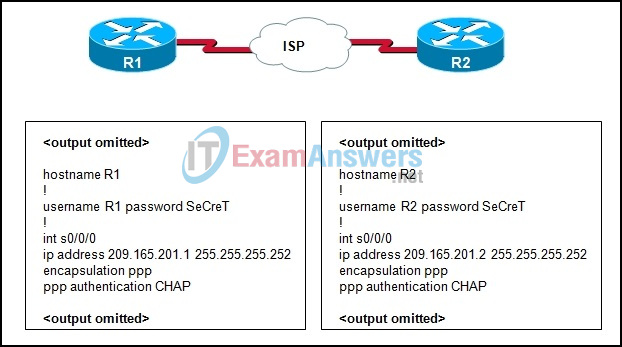
- Usernames on both routers R1 and R2 are misconfigured.
- The passwords are identical on both routers.
- The encapsulation command is entered incorrectly.
- The IP addressing scheme has incorrect subnet masks.
55. Refer to the exhibit. What is represented by the Null0 route for the 128.107.0.0 network?

- a child route that is defined
- a parent route that is defined and sourced from a physical interface
- a summary route for advertising purposes, not an actual path
- the result of the no auto-summary command on a router
56. Which command should a network administrator issue to disable default summarization in an EIGRP network?
- Router(config-router)# no ip summary-address
- Router(config-if)# no ip summary-address
- Router(config-if)# no auto-summary
- Router(config-router)# no auto-summary
57. Refer to the exhibit. Which two statements are true about the output that is shown? (Choose two.)

- The feasible distance to network 172.20.2.0 is 2172416.
- The reported distance to network 172.20.4.0 is 2172416.
- Serial 0/0/1 represents the next hop interface for network 172.20.4.0.
- Two routes in the routing table would be used to load-balance traffic to network 172.20.3.0.
- The letter P represents that the algorithm is calculating and the routes are not in use.
58. Refer to the exhibit. Both routers are configured to use the EIGRP routing protocol. However, when the show ip eigrp neighbors command is issued at R1, the output displays that the routers are unable to establish adjacency. What is the possible cause of this problem?
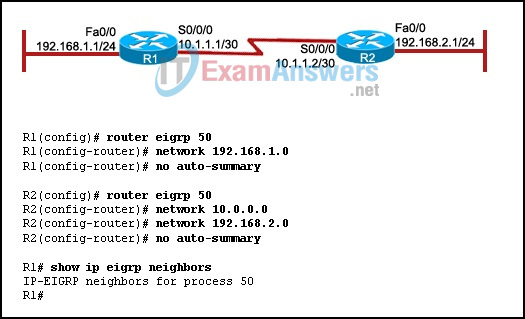
- EIGRP routing is incorrectly configured at R1.
- The autonomous system number is the same on both routers.
- The no auto-summary command is applied on both routers.
- The IP address of the serial interfaces of both routers is incorrectly configured.
59. Refer to the exhibit. What can be determined from the output of the show ip nat translation command?

- Dynamic NAT addressing is enabled.
- NAT overload is enabled on router R1.
- The outside local and outside global addresses have been misconfigured.
- The outside global address has been dynamically assigned from a NAT pool.
Refer to the exhibit. R1 is configured for inter-VLAN communication as displayed. PC1 is able to ping PC2 but unable to ping PC3. What is the cause of this problem?
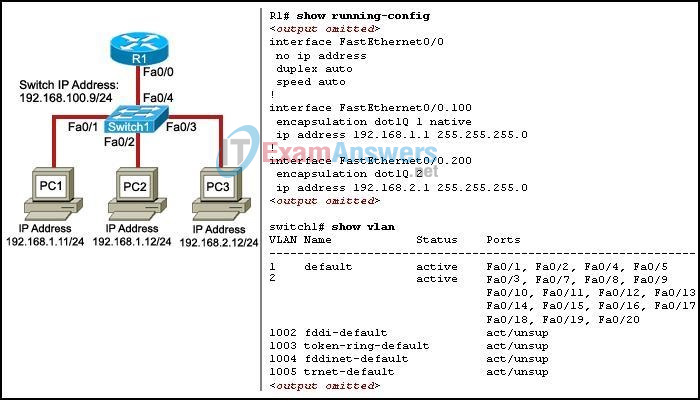
- PC3 and the FastEthernet0/0 interface of R1 are not on the same subnet.
- Fa0/1 is configured for access mode.
- Fa0/4 must be configured as a trunk.
- PC1 and the switch are not on the same subnet.
A company is using a Class B IP addressing scheme and expects to need as many as 150 networks. What is the correct subnet mask to use with the network configuration?
- 255.255.0.0
- 255.255.240.0
- 255.255.254.0
- 255.255.255.0
- 255.255.255.128
- 255.255.255.192
16. What will allow a LAN switched network to maintain VLAN configuration consistency across the network?
- Enable CDP on all switch access ports.
- Configure DTP on all trunk ports.
- Enable STP on all switches.
- Configure VTP on all switches.
17. Assuming VLSM is not being used, what impact will adding the command ip route 172.16.64.0 255.255.240.0 serial0/0 have on a router that is already operational in a network?
- All packets with a destination address between 172.16.64.1 and 172.16.80.254 will be forwarded out serial0/0.
- All packets with a destination address between 172.16.64.1 and 172.16.255.254 will be forwarded out serial0/0.
- All packets with a destination address between 172.16.64.1 and 172.16.79.254 will be forwarded out serial0/0.
- All packets with a destination address between 172.16.0.1 and 172.16.64.254 will be forwarded out serial0/0.
18. Which WAN connection method uses a PVC?
- leased line
- ISDN
- DSL
- Frame Relay
Refer to the exhibit. All routers are configured with RIPv2. What will be the result of the exhibited configuration?
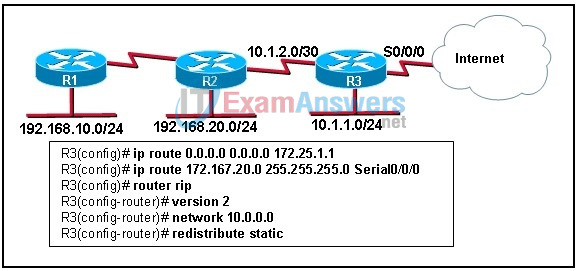
- All static routes on R3 will be propagated to R1 and R2.
- The default route on R3 will be propagated to R2 but not R1.
- Only the default route on R3 will be propagated to R1 and R2.
- No static routes will be propagated until a no auto-summary command is entered on R3.
All OSPF routers in a network have been configured to use MD5 authentication. Which two statements describe the reasons for using this technology? (Choose two.)
- All data passing between OSPF routers will be encrypted.
- MD5 authentication ensures the integrity of the network information.
- MD5 authentication optimizes bandwidth use on point-to-point links.
- MD5 authentication will ensure that only routers with matching keys share routing updates.
- The MD5 key will be sent to adjacent neighbors in plain text, after which OSPF updates will be encrypted.
25. Once the root bridge has been determined, which two items are assigned to every other switch before STP converges a switched network? (Choose two.)
- VLAN ID
- root port
- full-duplex port
- designated port
- discarding port
Refer to the exhibit. Assuming that the RIPv1 routing protocol is enabled and all networks have been correctly configured on each router, which statement is true?
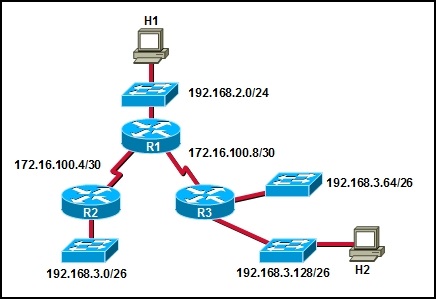
- All packets from H1 that are destined to H2 will arrive at H2.
- None of the packets from H1 that are destined to H2 will arrive at H2.
- Approximately half the traffic from H1 that is destined to H2 will reach R3.
- Some of the packets from H1 that are destined to H2 will be sent to the switch that is connected to network 192.168.3.64/26.
27. What information is displayed in the output of the show version command on a router?
- interface addresses
- routing table entries
- amount of flash memory
- configured routing protocols
28. What factor is important to consider when configuring manual summarization with EIGRP?
- EIGRP authentication must be enabled.
- Networks that are being summarized must be contiguous.
- Networks that are being summarized must use the same subnet mask.
- Summarization must be configured the same on all interfaces.
29. An organization is planning to expand by adding five new branches. After the expansion, it will require secured, full-time, and simultaneous connectivity for its new branch offices with the central office. There is only one port available on the central office router. Which WAN technology can be used in this situation?
- PPP
- ISDN
- Frame Relay
- analog dialup
Refer to the exhibit. A network technician has added router R0 to an existing network that contains router R1. R0 is configured with EIGRP and is connected to R1 via the Fa0/0 interface of each router. After completing an analysis of the network, the technician notices that the routes to the networks that are supported by routers R0 and R1 are not being exchanged. What is a possible cause for this failure?
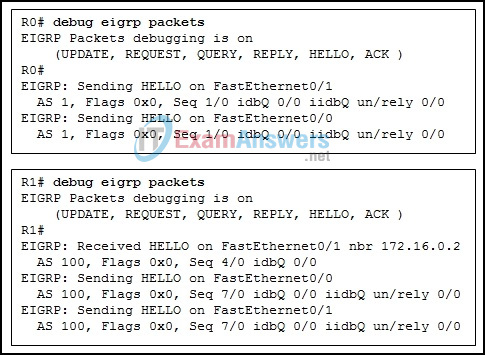
- R0 was configured with the wrong autonomous system number.
- FastEthernet interfaces on R0 are in a shutdown state.
- Interface Fa0/0 on R0 is configured as a passive interface.
- Interface Fa0/0 on R1 is configured as a passive interface.
Refer to the exhibit. Both switches have been configured with static VLANs. Host A and host C belong to one VLAN and host B and D belong to another VLAN. However, the hosts within the same VLAN are unable to communicate with each other. Which troubleshooting approach should be followed to resolve this problem?
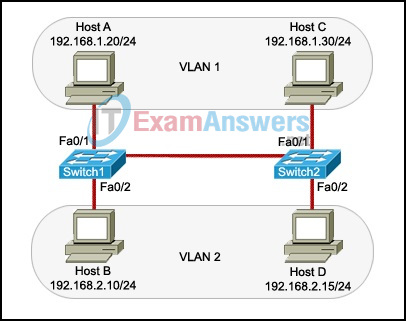
- Explore the possibility of adding a router to the network.
- Ensure that both switches are configured for the same native VLAN.
- Ensure that the ports connecting the two switches are configured as trunk ports.
- Ensure that both switches are configured with an IP address in the same subnet.
Refer to the exhibit. In order to establish a default route to the ISP, which two commands need to be issued on R2 so that R1 receives a default route from R2? (Choose two.)
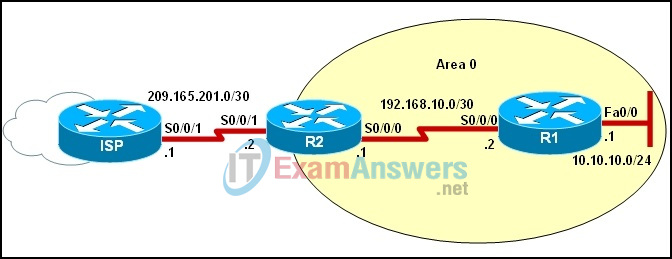
- R2(config-router)# area 0 range 0.0.0.0 0.0.0.0
- R2(config)# ip default-gateway 209.165.201.1
- R2(config-router)# default-information originate
- R2(config)# ip route 0.0.0.0 0.0.0.0 209.165.201.2
- R2(config)# ip route 0.0.0.0 0.0.0.0 serial 0/0/1
- R2(config)# ip route 0.0.0.0 0.0.0.0 serial 0/0/0
Refer to the exhibit. R1 is using the default OSPF operation. Which IP address will be used as the router ID of R1?
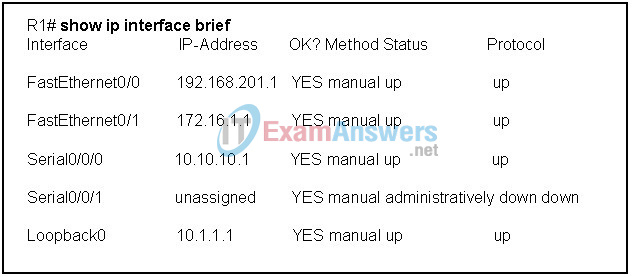
- 192.168.201.1
- 172.16.1.1
- 10.10.10.1
- 10.1.1.1
36. Which two criteria are used by STP to select a root bridge? (Choose two.)
- memory size
- bridge priority
- number of ports
- switch location
- switching speed
- base MAC address
37. What are two characteristics of an extended ACL? (Choose two.)
- IP is used to specify TCP traffic only.
- IP is used to specify TCP and UDP traffic only.
- IP is used to specify all TCP/IP protocols including TCP, UDP, ICMP and routing protocols.
- Traffic can be filtered on source address only.
- Traffic can be filtered on source and destination address only.
- Traffic can be filtered on source and destination address, protocol, and specific port number.
38. Which two interface values does EIGRP use by default to calculate the metric? (Choose two.)
- bandwidth
- delay
- load
- hop count
- reliability
39. What is a limitation of RIPv1?
- RIPv1 cannot run on networks that are using RIPv2.
- RIPv1 does not send subnet mask information in its updates.
- RIPv1 is not widely supported by networking hardware vendors.
- RIPv1 requires enhanced router processors and extra RAM to function effectively.
- RIPv1 consumes excessive bandwidth by multicasting routing updates using a Class D address.
40. What is a feature of PAP authentication?
- It uses a three-way handshake with encryption.
- It sends the username/password pair across the link in clear text.
- It provides protection against playback attack through a variable challenge value.
- It designates the called device to control the frequency and timing of the authentication.
41. Which element of the hierarchical design model provides a connection point for end-user devices to the network?
- core layer
- edge device
- access layer
- enterprise edge
- distribution layer
Refer to the exhibit. Which commands would be used to configure OSPF on router R1?
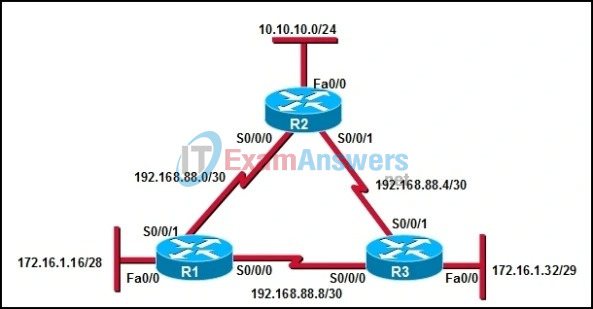
- R1(config)# router ospf 1
R1(config-router)# network 172.16.1.16 255.255.255.248 area 0
R1(config-router)# network 192.168.88.0 255.255.255.0 area 0
R1(config-router)# network 192.168.88.8 255.255.255.0 area 0 - R1(config)# router ospf 1
R1(config-router)# network 172.16.1.16 0.0.0.15 area 0
R1(config-router)# network 192.168.88.0 0.0.0.3 area 0
R1(config-router)# network 192.168.88.8 0.0.0.3 area 0 - R1(config)# router ospf 1
R1(config-router)# network 172.16.1.0 0.0.0.7 area 0
R1(config-router)# network 192.168.88.0 0.0.0.3 area 0
R1(config-router)# network 192.168.88.8 0.0.0.3 area 0 - R1(config)# router ospf 1
R1(config-router)# network 172.16.1.16 0.0.0.3 area 0
R1(config-router)# network 192.168.88.4 0.0.0.3 area 0
R1(config-router)# network 192.168.88.8 0.0.0.3 area 0 - R1(config)# router ospf 1
R1(config-router)# network 10.10.10.0 0.0.0.255 area 0
R1(config-router)# network 172.16.1.16 0.0.0.15 area 0
R1(config-router)# network 172.16.1.32 0.0.0.7 area 0
R1(config-router)# network 192.168.88.0 0.0.0.3 area 0
R1(config-router)# network 192.168.88.4 0.0.0.3 area 0
R1(config-router)# network 192.168.88.8 0.0.0.3 area 0
Which route will be excluded from the updates that are sent to the neighbor routers?
- R 192.168.1.0/24 [120/1] via 192.168.100.1, 00:00:12, FastEthernet0/1
- R 192.168.2.0/24 [120/15] via 192.168.101.1, 00:00:12, FastEthernet0/0
- R 192.168.3.0/24 [120/2] via 192.168.101.1, 00:00:12, FastEthernet0/0
- R 192.168.4.0/24 [120/7] via 192.168.101.1, 00:00:12, FastEthernet0/0
Refer to the exhibit. If R4 is announcing all shown internal networks as a summary address to the ISP, which summary address will be most specific?

- 192.168.1.0/22
- 192.168.4.0/21
- 192.168.6.0/23
- 192.168.8.0/21
- 192.168.4.0/22
Refer to the exhibit. How many routers have established OSPF adjacencies with R1?

- 2
- 4
- 5
- 7
